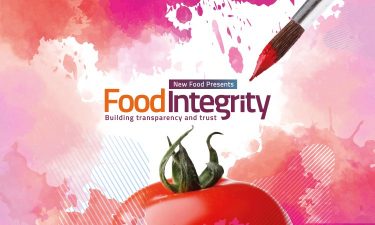The future of protein
- Like
- Digg
- Del
- Tumblr
- VKontakte
- Buffer
- Love This
- Odnoklassniki
- Meneame
- Blogger
- Amazon
- Yahoo Mail
- Gmail
- AOL
- Newsvine
- HackerNews
- Evernote
- MySpace
- Mail.ru
- Viadeo
- Line
- Comments
- Yummly
- SMS
- Viber
- Telegram
- Subscribe
- Skype
- Facebook Messenger
- Kakao
- LiveJournal
- Yammer
- Edgar
- Fintel
- Mix
- Instapaper
- Copy Link
Posted: 24 February 2020 | Dr Wayne Martindale | No comments yet
The meat-free movement has changed the protein market for good. Dr Wayne Martindale, Associate Professor, Food Insights and Sustainability at the University of Lincoln, tells all.


The meat-free market has changed everything we thought we knew about consumer habits, it has also heralded a new view of what food sustainability and integrity means for food manufacturers.
The profiles of personal nutrition, carbon footprints of beef and the ethics of food production are currently driving consumers to switch preferences and change long-standing eating behaviours. This step change is not just a meat versus no-meat stand-off; it highlights the value of protein choices available to consumers and their sustainability outcomes.
Meat-free, protein balance and ‘fad diets’
The analysis presented here identifies many commercial opportunities and shows how improved consumer experience of foods and beverages can be achieved by better understanding proteins. It calls for the industry to lead on consumer communications where meat-free transitions have already given insights on the value of dietary protein to health and the environment.
Any diet that does not put protein at its centre will be a poor one.
Protein is still very much a blind spot; after all, how many of us know how much protein we should consume each day, what types are most appropriate and how their quality varies? These types of choice values are acknowledged by consumers for dietary calorific requirements – and even the environmental impact has been described for calories – but this is not the case for protein.1 This is a significant gap in our approach to New Product Development (NPD). Any diet that does not put protein at its centre will be a poor one and this is evident at a time when England’s National Health Service calls for consumers to not follow ‘fad diets’, a sentiment that is probably echoed by many medical professionals who witness the results of them.2 What is notable in these communications is that protein is rarely mentioned despite existing concerns that no-meat trends can result in nutrient deficiencies.
Sustainable diet
Personalised protein requirements provide an industry focus for sustainable eating. The value of protein is rarely integrated into NPD processes and a recent UK Knowledge Transfer Network whitepaper summarises our current understanding of protein recommendations.3 It reports that the wider impacts of poor protein supply at population or meta-NPD scales will be poor health and there is little consideration that protein requirements are variable throughout our lives.
The daily amount of protein required is 0.8 grams for each kilogram of bodyweight, but the metabolic requirement for protein is not as well communicated as for calories. Industry-led solutions have already been established; the development of whey protein ingredients into functionalities for taste and performance is testament to this and it can now go further.4 The meat-free and mycoprotein industry has had an incredibly innovative role in this respect, having brought new products to market and informing consumers.5
Taste and New Production Development (NPD) drivers for proteins
Developing protein-focused dietary recommendations is not straightforward; even global expert panels get them confused or tie them up in analysis that is rarely relevant to consumers. The disagreements between expert panels show the meat-eating issue can easily start arguments that have little relevance to consumers.6,7 If these panels cannot effectively communicate how many rashers of bacon is safe to eat, then there is little hope of science ever breaking through details to help consumers make responsible choices. This is


Demand for meat replacement proteins has been driven by an understanding of what meat eaters most enjoy about meat consumption, such as the flavour and texture, and then developing products that have similar qualities
where the non-meat and meat replacer sectors have shown real innovation in NPD, by getting products to retail and service outlets that were unthinkable 10 years ago – and they are clearly consumer focused.
These are the real science and innovation solutions that resonate with consumers and still provide the high-level health and environment outcomes that global panels seek. This market currently depends on mycoprotein and plant-derived proteins that will begin to diversify with clean or lab-grown meat and insect proteins that are still scaling up production.
Importantly, the demand for meat replacement proteins has been brought about by understanding what meat eaters most enjoy regarding eating meat, and then developing products that deliver these functions for consumers. It has not been achieved by telling consumers not to eat meat because of nutritional or environmental impact and this is a step change that much of the analysis of protein markets still overlooks.
How to change New Product Development (NPD)
Given what has happened in the meat-free transition, our industry now has the tools to understand the quantity and quality of protein supply, but many NPD strategies still ignore them, and public health trends demonstrate this. This presents an NPD opportunity to place protein ingredients and foods at the centre of every plate, but an assessment of how the value of protein can be communicated to consumers who are already eating plant protein-dominated diets is needed.
The typical plant protein content of a North American’s diet is 37 percent and for a typical European it is 43 percent, with dairy followed by poultry categories dominating the livestock components of diets. This is the protein profile that we know requires diversification. However, transitioning protein choices to more plants is not without concern because protein deficiency is an emerging issue.
The beef industry is responding to the meat-free movement in innovative ways that other meat categories will no doubt follow.
The Japanese diet has been cited as an exemplar of good practice in this respect by the Food and Agriculture Organization of the UN (FAO) because it breaks up dominance of cereal proteins with fish and legume categories, but is highly dependent on imports to integrate diversification with sufficiency.8 The meat-free brands are testament to diversification. The innovation leaders in meat-free materials such as extruded vegetable protein and mycoprotein were on the fringes of the industry a decade ago but now they are centre plate with national food services and retailers.
The marketplace for proteins and scaling change
Projecting how the ingredient markets respond to changes in taste and the nutritional requirements of consumers is a core business strategy for any innovative food and beverage company.9 Protein supply has transitioned from one of trade in commodities dominated by nations who can export the greatest volumes, to one of quality and function.


Alternative meat products are becoming commonplace on the supermarket shelves; could lab-grown meat be the next big thing?
Protein commodities still dominate protein markets compared to meat replacers with protein exports led by maize at 12 percent of the billion tonnes produced, soybeans at 38 percent of the 278 million tonnes produced, and wheat at 28 percent of the 708 million tonnes produced. Livestock proteins are dominated by milk with 17 percent of 753 million tonnes produced exported, meat production is dominated by pork at 113 million tonnes, poultry at 109 million tonnes, and beef at 68 million tonnes.
Typically, less than 20 percent of meat production is exported because it is of high economic value and produced regionally. A notable exception is sea fish where 63 percent of the 36 million tonnes of pelagic fish are exported. Aquaculture is rightly seen as the disruptor of the global protein balance here, with the potential to close protein gaps, with 52 million tonnes produced each year. Soybeans and wheat are the most transported plant protein crops because they can be stabilised by basic processing to be utilised as feeds and food ingredients. Maize is principally used as feed in regional markets where it has become a critical point for protein supply with land use change and deforestation a high-profile issue for soybean production.10 Solutions for sustainable feed supply will be critical to maintain livestock and fish production so new protein sources such as insect pupae and industrial proteins will have important future applications as feeds.11
What about beef?
Beef is often the target for many of the reported reasons not to eat meat and the beef industry is responding to this in innovative ways that other meat categories will no doubt follow. They include increasing the transparency of production data to provide greater product integrity, which seems tough to do for a product that has a carbon footprint that is 15 times that of wheat. The scale of this is expected because forages, soybean and wheat feeds convert to beef protein. What is overlooked, however, is that the protein content for beef will often be double that of plant proteins and it supplies essential nutrients, including Vitamin B12, essential amino acids and a suite of other micronutrients that are more difficult to source from plants.
Interested to hear more on this topic? Join Dr Wayne Martindale at Food Integrity 2020 where he will be part of an expert panel session discussing the challenges around sustainability and how we can drive towards a more environmentally-friendly future. Visit: foodintegrityevent.com for more information, including the agenda and a list of speakers.


A further consideration is that carbon footprints are typically expressed in kilograms of product and it would be rare to eat a kilogram of beef in one sitting, so the environmental load is spread across several meals. Yet again, assessments do not relate to consumer requirements and beef is the exemplar case of misrepresentation here; it has a high carbon footprint, but it is the frequency at which it is consumed that is problematic rather than the product itself.
Research has shown the carbon and water footprint of beef can vary depending on where it is produced, and sustainable grazing initiatives can reduce impact. In rain-fed regions where pasture grazing is possible for most of the year, the environmental impact of production is lessened and even enhances environment.12 These production systems are often omitted from discussions on the environmental impact of beef production and it has been beef producers who have identified opportunities to produce carbon‑neutral beef products that are game changers for the meat industry.13 This is important because these producers have seen where the criticism of their products is derived, and they have understood the consumer requirements of them so that their supply chains can adjust to meet new developments. This response has all the components of integrating NPD with consumer requirements, integrity and environmental assurance.
The solution for beef has been to present information to consumers with transparency using new technologies such as blockchain and identifying carbon-neutral solutions.14 The development of any protein market is dependent on the ability to communicate claims that resonate with consumers so that responsible protein consumption happens. This will not be achieved by asking consumers to not eat meat; it will be achieved by innovative NPD that can incisively demonstrate the integrity of products.
About the author
Since 2018, Dr Wayne Martindale is the Associate Professor, Food Insights and Sustainability at the University of Lincoln. He has brought over 20 years’ experience into leading the Food Insights and Sustainability Research Group at the National Centre for Food Manufacturing. The food innovation folio he leads delivers applied research with manufacturers and technology integrators. Wayne’s post-doctoral biotechnology research was completed in the mid 1990s at the University of Florida and Rothamsted. Following this, he entered commercial research with Levington Agriculture leading technical communications. He has since worked at the Australian Government’s science agency- CSIRO, the European Commission’s Joint Research Centre and the OECD leading research applied to the traceability of fuels, feeds and foods.
References
1. Drewnowski A, Rehm CD, Martin A, Verger EO, Voinnesson M, Imbert P. Energy and nutrient density of foods in relation to their carbon footprint. Am. J. Clin. Nutr. 2014, 101, 184–191
2. ‘Slim Chance Of Success’ With Quick-Fix Diets, Warns England’s Top Doctor https://www.england.nhs.uk/2019/12/quick-fix-diets/
3. Protein for Life: A framework for action https://ktn-uk.co.uk/news/protein-for-life-a-framework-for-action
4. High-quality protein solutionshttps://www.kerry.com/products/nutrition/proteins
5. Mycoprotein is a unique and nutritious protein that can be part of a balanced diet and also supports the health of the planet https://www.mycoprotein.org/
6. The EAT–Lancet Commission: a flawed approach? https://www.thelancet.com/journals/lancet/article/PIIS01
40-6736(19)31903-8/fulltext
7. The EAT–Lancet Commission: a flawed approach? – Authors’ reply https://www.thelancet.com/journals/lancet/article/PIIS0140-6736(19)31910-5/fulltext
8. Japan is a global model for healthy diets, FAO Director-General says http://www.fao.org/news/story/en/item/885019/icode/
9. McDonald’s and Mondelez Say Taste, Not Health, Will Drive Food Sales https://www.wsj.com/articles/mcdonalds-and-mondelez-say-taste-not-health-will-drive-food-sales-11570536308
10. Trendy foods should come with a recipe for sustainability https://theconversation.com/trendy-foods-should-come-with-a-recipe-for-sustainability-65766
11. Insect meal now in commercial Skretting feed https://www.skretting.com/en/settings/news/general-news/insect-meal-now-in-commercial-skretting-feed/
12. Ridoutt BG, Eady SJ, Sellahewa J, Simons L, Bektash R. Water footprinting at the product brand level: case study and future challenges. Journal of Cleaner Production 17, 1228–1235 (2009)
13. Arcadian is a 100% Carbon Neutral Business https://www.arcadianorganic.com.au/arcadian-is-a-100-carbon-neutral-business/
14. Blockchain solution for the Australian beef supply chain https://beefledger.io/
Issue
Related topics
Cultured Meat, Free From, Ingredients, New product development (NPD), Plant based, Proteins & alternative proteins, Research & development, retail, Supermarket, Sustainability, Technology & Innovation, The consumer








